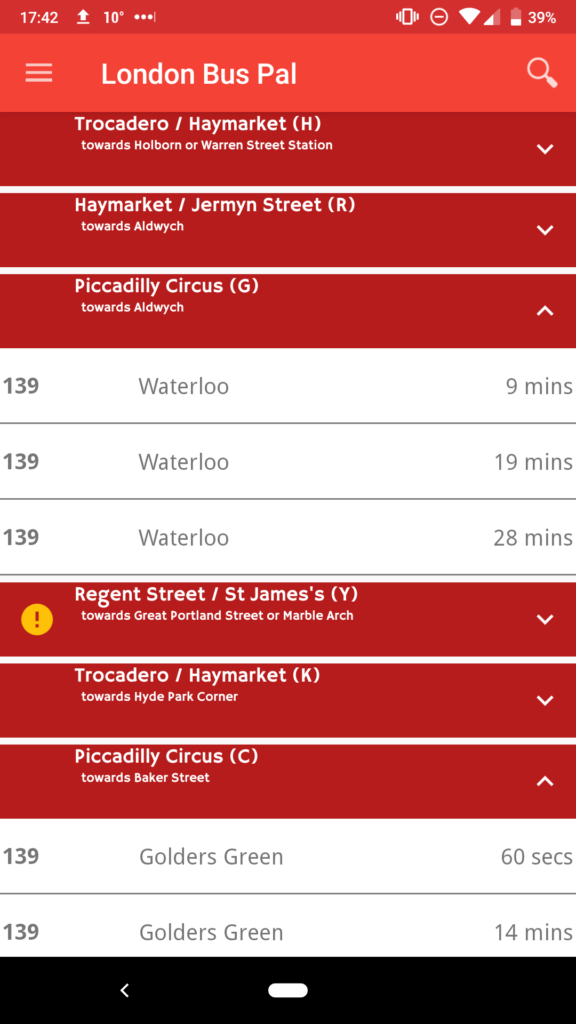As I’ve just published a fourth major revision of my app, I thought I would relive the history of the app just to see how far it’s come:
Version 1 – the prototype
This was my first attempt at ever making an Android application. I used Google Web Toolkit which I then rendered in a web view in the application (basically GWT compiles into very optimised Javascript). Not being a fully native app wasn’t really an issue since I managed to successfully do callbacks between the app and the web view, so the app would handle things like a user pressing the back button or doing an in-app search without any hassle. Correctly handling the user pressing the back button is something which stands out for me.
This version was first published on 6 September 2013, version 1.0.1 (incorrectly numbered 1.01) followed 2 hours later and version 1.0.2 followed 2 days later.

Opening version 1 with no nearby stops (as I no longer live in London) just shows a blank screen. I see no options and I clearly deployed a version with no ads enabled!
Version 1.1.7 was the final instalment of version 1 and went live on 28 December 2013. When I now open the app, I see an error (as I am not anywhere near London), but it is quite generic and could really be anything.
Improvements I can see is a loading indicator, the search bar looks much better and a new map icon which appeared. The map views have always annoyed me as I haven’t given it too much attention. Something else which is quite obvious is that the lines are not high enough for a touch device.
Version 2 – going native

The first release of version 2 was in October 2014. I rewrote the entire app to get rid of Google Web Toolkit and all the callbacks between basically a front-end and back-end.
Opening version 2.0.0, it looks very much like a minor change from version 1.1.7 (except I know it was a substantial change!). The one thing which is obvious is that the listview tiles have become even tighter.
Fast forwarding to version 2.1.3, the list view is still very “tight”. The changes I can see from version 2.0.0 are: I can now search for specific bus stops by name and we now have some settings. In the settings I can see that by this time I changed my implementation to allow more granular view of nearby buses (showing in 15 seconds intervals rather than seeing “due” for 90 seconds, which can feel like forever if you are waiting for a bus!).
Version 3 – material design

Version 3.0.0 was released only a week after 2.1.3, but I had been working on it for quite some time. This version was all about material design and it was fairly cutting edge, as material design was only announced in June of the previous year. The design hasn’t changed too much since this release – apart from a styling change for dialogs. The main design has remained fairly similar since. In the back, there were a fairly large amount of moving parts, but most of this would have been invisible to users.
The next notable update was in May 2018 with GDPR coming around. With 3 days to spare, I put out the GDPR release on 22 May. This caused so many headaches that I had to try again several times to the point where I actually started over and finally released the last version on 7 June 2018.
Version 4 – Flutter and iOS

At work, a colleague told me about Flutter and I decided to investigate. Having looked at it, it seemed to be a really easy implementation of material design and there was the added bonus of being able to also build apps for iOS. I’ve had some requests to also make my app for iOS, but I didn’t want to end up having to maintain two code bases, the only way I would do that is if I ended up with a single code bases. I had considered many times if I should go back to my version 1 design to facilitate this. Early in November, I installed Flutter. It was a slow start, but I gained speed and confidence really quickly that I was using the right technology.
On 16 December, I published version 4.0.0 of London Bus Pal. Not as an Android app, but as an Apple app. I wanted to try the Apple deployment process and see if I missed anything major. And I was still missing map views, so I decided to soft launch on Apple and Android would follow once I had map views in place. Finally on 26 December, I launched version 4.0.3 on Android. Being another rewrite, it is quite nerve wracking, because things which were previously fixed or just stable, might not work. I have seen a few small issues, but not being used to the new error reporting software, I don’t always know if my users can see all of the errors.
What’s next?
Well, for now I’m going to focus on stabilising version 4 of London Bus Pal. The way it has been designed now, means that it should be quite easy to add new features. But I might just leave it alone, because I have a steady following of users.
What a transformation! It looks like it’s always improved – well done.
[…] did an earlier post on my app’s version history, where I walked through all the versions of my app from 2013 onwards. I was slightly surprised when […]